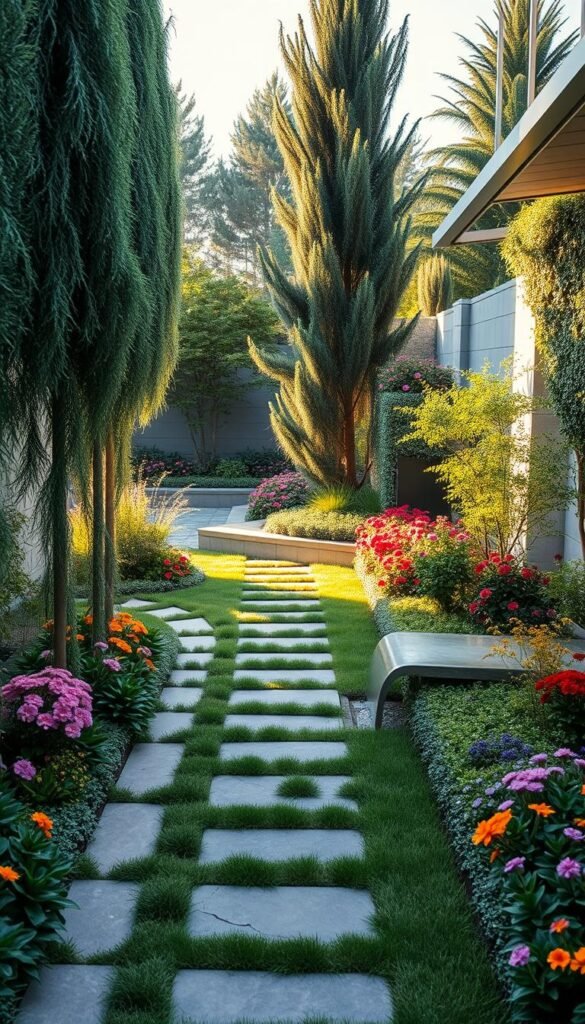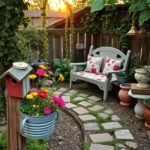Dreaming of a lush retreat but working with limited square footage? You’re not alone. Whether you have a cozy balcony, a narrow patio, or a compact backyard, smart design choices can turn even the smallest areas into inviting escapes. Let’s explore how to reimagine your surroundings with creativity and purpose.
Great spaces begin with clever layouts. Vertical planters, hanging baskets, and tiered displays let you grow more without sacrificing floor space. Pair these with strategic lighting to extend your enjoyment into the evening—perfect for summer gatherings or quiet moments alone. For inspiration on maximizing tight corners, check out these small garden ideas that balance form and function.
Don’t overlook the power of personality. Repurposed items like vintage ladders or galvanized containers add rustic charm while keeping costs low. Want to blend old and new? Discover how vintage garden decor ideas can create conversation-starting focal points without overwhelming your layout.
We’ll guide you through assessing your area, selecting plants that thrive in your conditions, and arranging elements for visual flow. You’ll learn to turn challenges—like awkward angles or limited sunlight—into opportunities that reflect your unique style. Ready to craft an oasis that feels both spacious and intimate? Let’s dig in.
Understanding Your Outdoor Space Potential
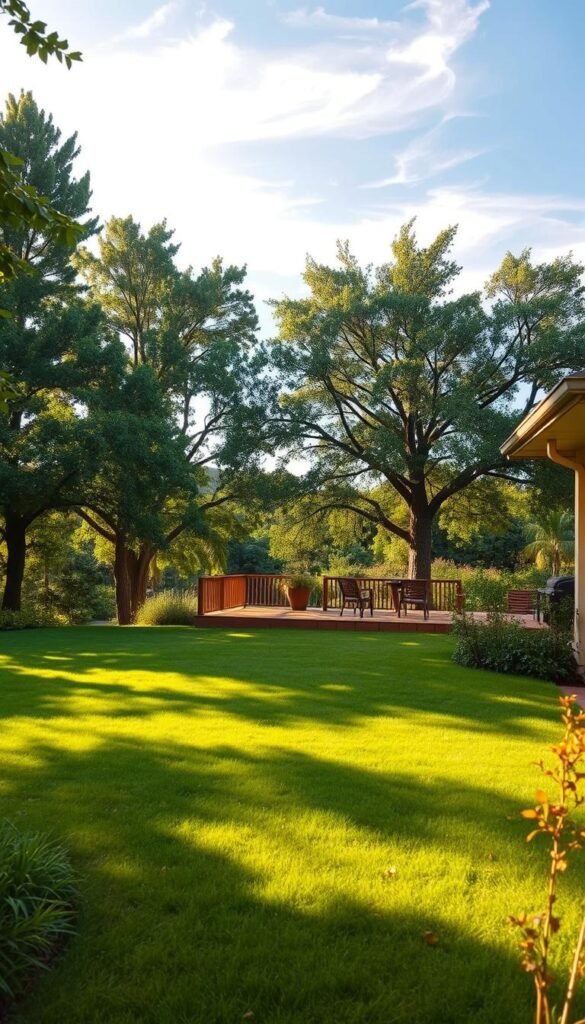
Your yard holds hidden opportunities waiting to be discovered. Start by observing it through new lenses – literally. Stand at your windows and note what catches your eye first. This indoor perspective matters most when rain or snow keeps you inside, yet you still crave nature’s calming presence.
Assessing Your Available Area
Grab a tape measure and notebook. Sketch your plot’s boundaries, marking permanent features like trees or pathways. Track sunlight patterns for 3 days – morning shade here might mean perfect ferns there. Notice where water pools after storms; these spots could host thirsty plants instead of becoming muddy problems.
Finding Your Garden’s Unique Character
That rocky patch? A future succulent showcase. The sloped corner? Ideal for terraced herbs. Your space’s quirks become its signature style when embraced. Test soil pH with a $7 kit from any garden center – acidic earth means happy blueberries, while alkaline conditions suit lavender perfectly.
Prioritize elements you’ll see daily from your kitchen window or favorite chair. A vibrant container arrangement near the back door delivers more joy than hidden features. Remember: Great designs work with your land’s natural flow, not against it.
Planning Your Garden Layout for Maximum Impact
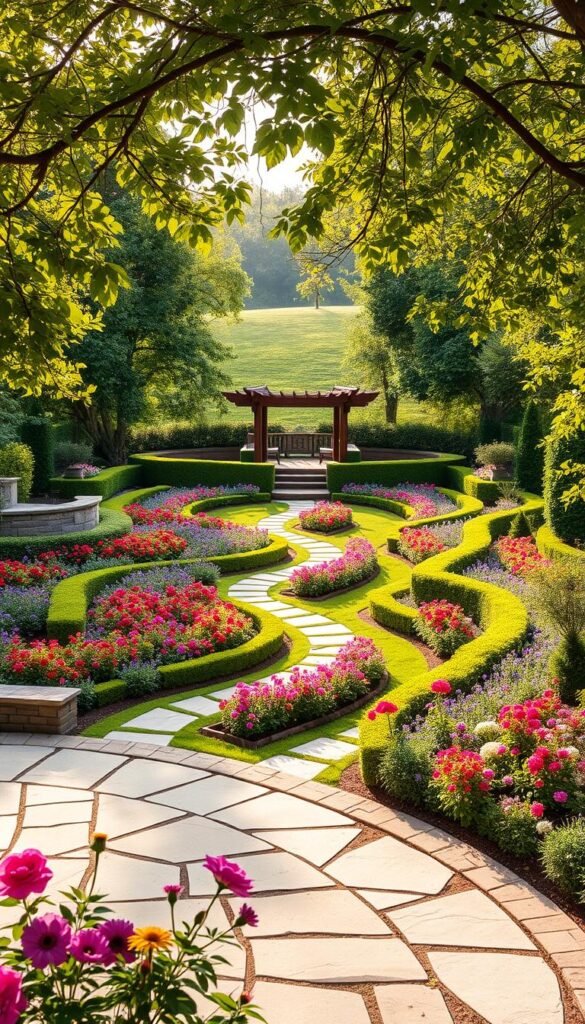
Crafting a functional yet beautiful outdoor area starts with smart spatial organization. Think of your plot as a blank canvas where every inch matters. Clever zoning tricks can turn cramped quarters into multi-functional retreats that feel expansive and purposeful.
Segmenting Your Space Strategically
Divide your plot using nature’s own tools. A low stone wall creates a dining zone, while tall grasses mark a meditation corner. Try these simple dividers:
- Raised beds with trailing thyme between seating areas
- Potted trees that screen a reading nook
- Gravel pathways leading to hidden benches
These boundaries guide movement while tricking the eye into seeing depth. Even a 10’x10’ plot can host three distinct areas when planned thoughtfully.
Balancing Function and Aesthetics
Choose materials that serve dual purposes. Pebble mosaics add texture underfoot while directing rainwater. Built-in seating doubles as storage for garden tools. Keep sightlines open with airy plants like Russian sage near gathering spots.
Pathways should be wide enough for two people (36”-48”) but vary widths to create rhythm. Use chunky stepping stones in utility zones and smooth flagstone near lounging areas. A circular layout often works best, leading visitors through your carefully curated spaces without dead ends.
Remember: Bold features like a statement planter or sculptural trellis give eyes places to rest. These anchors make compact designs feel intentional rather than crowded.
10 Innovative Garden Ideas to Transform Your Outdoor Space
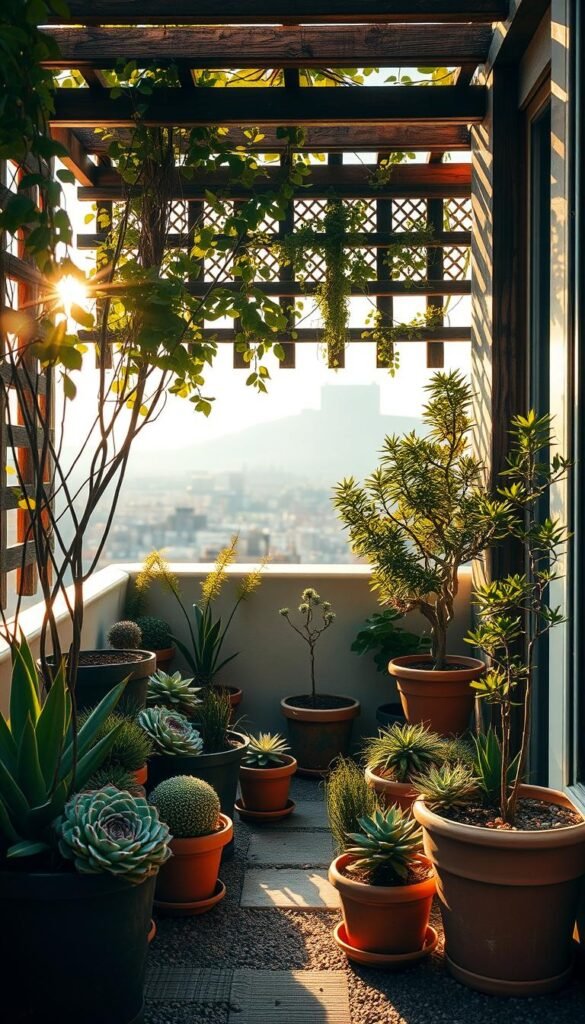
Who says petite plots can’t pack a punch? Redefine what’s possible in limited areas by embracing bold design strategies that create depth and character. The secret lies in playing with proportions and layering elements that engage the senses.
Scale Matters More Than Size
Oversized planters or a single statement tree often work better than multiple small pots in tight quarters. These bold focal points trick the eye into perceiving grandeur. Try pairing a large ceramic urn with trailing ivy beside a narrow bench – the contrast creates instant drama.
Here’s how professionals maximize impact in compact layouts:
| Strategy | Effect | Example |
|---|---|---|
| Vertical layering | Adds depth | Wall-mounted ferns above ground-level hostas |
| Monochrome palette | Unifies space | Various white-flowered plants in mismatched containers |
| Reflective surfaces | Amplifies light | Mirrored panels behind climbing roses |
The Art of Controlled Abundance
Embrace the “more is more” approach strategically. Cluster different-sized pots along walkways, stacking some on overturned crates for height variation. Mix textures – pair smooth-glazed planters with rough terracotta and woven baskets for tactile interest.
Rotate seasonal blooms in your containers to maintain year-round appeal. Spring tulips make way for summer geraniums, followed by autumn chrysanthemums. This living collage keeps your ever-changing masterpiece feeling fresh without overcrowding.
Creative Vertical Planters and Wall Gardens
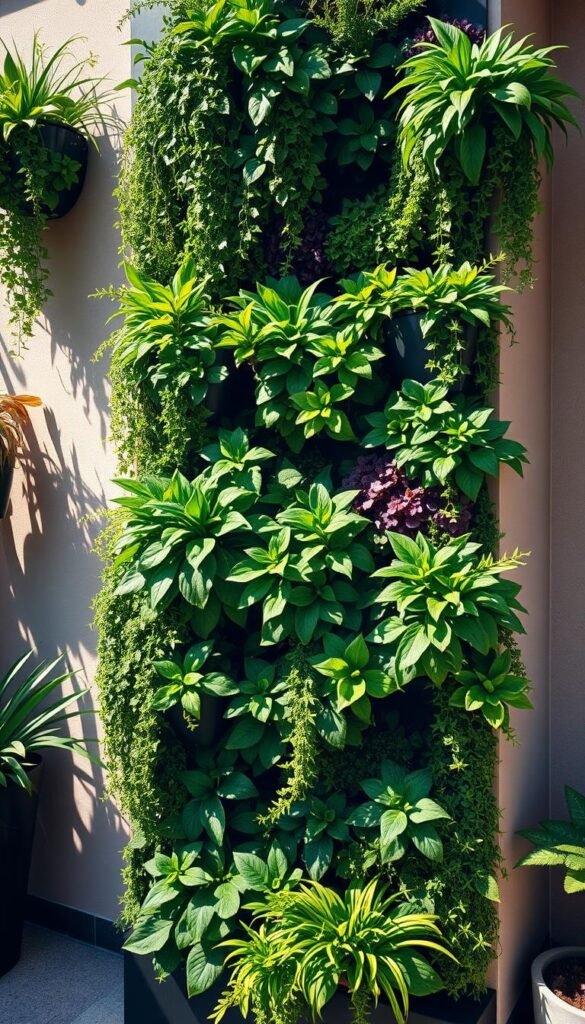
Blank walls become blooming masterpieces when you think upward. Vertical arrangements let you grow herbs, flowers, and succulents in tight spots while adding architectural interest to plain surfaces. Best part? You can build these space-saving systems yourself using everyday materials.
DIY Vertical Garden Solutions
Transform wooden pallets into instant green walls by lining them with landscape fabric and filling the slats with soil. For smaller projects, repurpose tin cans or shoe organizers – just add drainage holes and trailing plants like pothos or strawberries.
This table shows three beginner-friendly options:
| Material | Best For | Pro Tip |
|---|---|---|
| Pallets | Herb gardens | Stain with weatherproof paint |
| Wire mesh boxes | Succulents | Use cactus soil mix |
| PVC grids | Leafy greens | Install drip irrigation |
Vertical setups need 30% less watering than traditional beds. Their elevated position improves air circulation, reducing mold risks. Secure heavy planters to walls with sturdy brackets – safety first!
Choose compact varieties like dwarf tomatoes or creeping thyme for vertical success. Mix textures by pairing spiky aloe with soft ferns. Rotate pots seasonally to keep your living artwork dynamic year-round.
Incorporating Raised Beds and Container Gardening
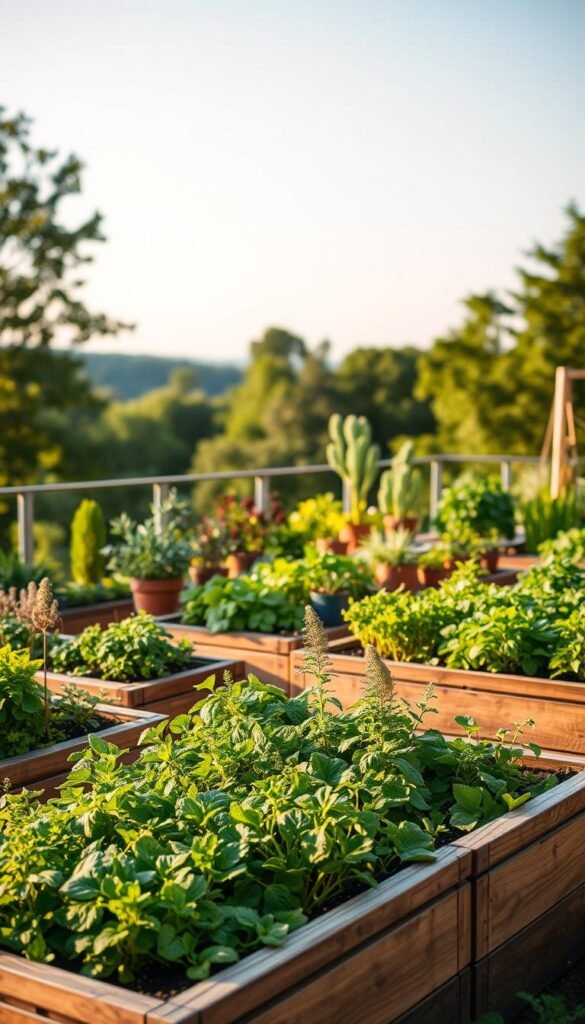
Elevate your planting game with solutions that marry practicality and style. Raised beds and containers unlock fresh possibilities for growers working with tight quarters, offering customizable layouts that adapt to your space and needs.
Why Raised Beds Shine
These elevated planters give roots room to breathe while preventing soil compaction. You control the dirt quality – perfect for fussy veggies like carrots or blueberries. Built at waist height, they eliminate back-breaking weeding and harvesting.
Smart gardeners maximize every inch:
- Install hinged lids that convert to potting benches
- Add pull-out drawers under beds for tool storage
- Use vertical trellises on bed frames for climbing beans
Container Mastery Made Simple
Pots let you rearrange your green scene like living decor. Group planters in odd numbers (3s or 5s) for visual harmony. Match colors to your home’s exterior – terracotta warms modern spaces, while glossy black pots pop against light walls.
| Container Type | Best Uses | Maintenance Tip |
|---|---|---|
| Terracotta | Herbs & succulents | Water 20% more often |
| Resin | Shade plants | Drill drainage holes |
| Fabric | Deep-rooted veggies | Fold edges for stability |
Mix trailing ivy with upright flowers in shared pots for instant drama. Remember: Bigger containers hold moisture longer, reducing summer watering chores. Your plants will thrive when their roots have space to stretch.
Designing Inviting Outdoor Seating and Entertainment Areas
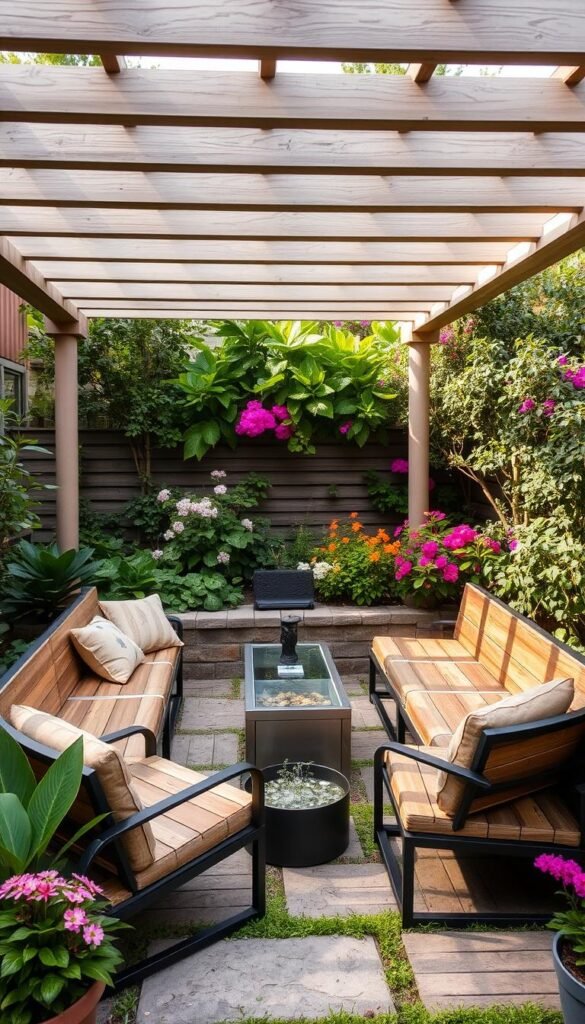
Your outdoor area deserves to be both beautiful and practical. Smart furniture choices create welcoming zones for relaxation and socializing without overcrowding. Let’s explore how to arrange your patio or deck for comfort and versatility.
Choosing Space-Saving Furniture
Push seating against walls or fences to free up central space. Built-in benches with lift-up lids offer hidden storage for cushions or tools. This approach keeps walkways clear while providing permanent seating for impromptu gatherings.
Narrow spaces thrive with slimline solutions. A 6-foot bench paired with a foldable table accommodates dinners for four yet tucks neatly against railings. For inspiration on adaptable entertaining setups, explore these outdoor seating arrangements that balance style and efficiency.
Multi-functional pieces work hardest in compact layouts:
- Storage ottomans triple as tables, seats, and toy boxes
- Stackable stools form side tables when not in use
- Convertible dining sets expand for parties then contract daily
Scale matters most. Low-profile furniture maintains sightlines, making your space feel larger. Arrange chairs 18-24 inches apart for easy conversation. Leave 36-inch pathways between seating clusters to ensure comfortable movement.
Enhancing Your Garden with Colorful Pots and Planters
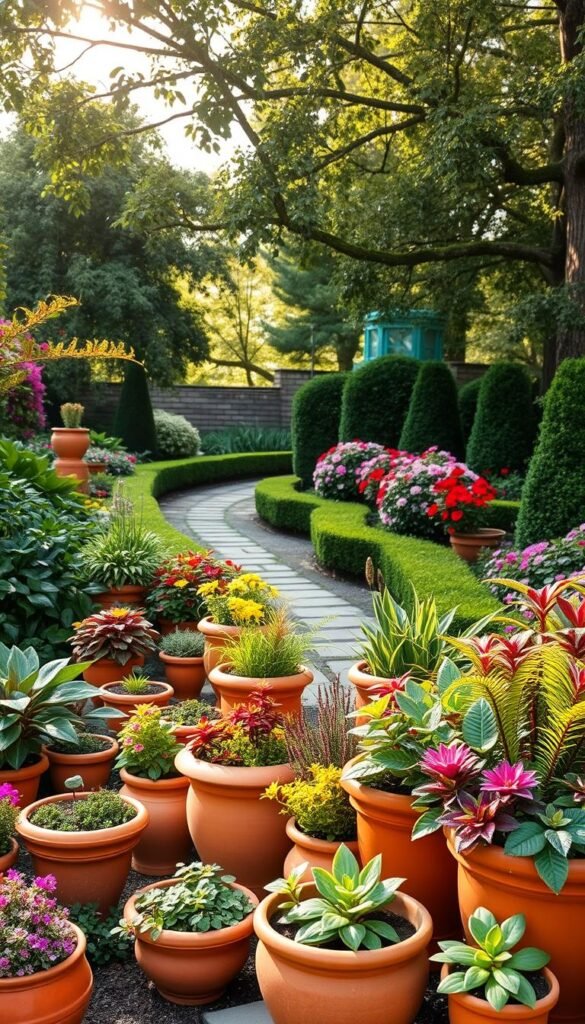
Color becomes your secret weapon when working with limited ground space. A well-placed cluster of pots transforms blank walls or empty corners into vibrant living art. Unlike traditional flower beds, containers let you experiment with bold hues and unconventional arrangements that evolve with your mood.
Think beyond basic terracotta. Upcycled tin buckets, weathered toolboxes, or even colanders make charming planters with personality. Group three mismatched vessels near your entryway – a tall ceramic urn flanked by mid-sized enamel pots creates instant curb appeal. For budget-friendly inspiration, explore these home gardening ideas that maximize impact without overspending.
Master color coordination by tying container hues to your home’s exterior. A cobalt blue pot echoes shutters, while warm terracotta complements brickwork. Use this simple formula:
- 60% dominant color (your home’s primary shade)
- 30% secondary tone (natural wood or stone accents)
- 10% pop color (seasonal blooms)
Elevate your displays with strategic stacking. Place large containers on the ground, medium pots on overturned crates, and small planters on wall shelves. This tiered approach adds depth to narrow patios. Choose drought-tolerant succulents or trailing ivy for low-maintenance beauty – they thrive in pots with proper drainage holes and fast-draining soil.
Rotate your container arrangements seasonally. Bright geraniums shine in summer, while ornamental kale adds winter texture. Remember: Odd-numbered groupings (3-5 pots) create natural-looking clusters that soften sharp architectural lines.
DIY Garden Projects and Unique Furnishings
Unleash your creativity with materials you already own. Transforming discarded items into functional art adds personality while keeping costs low. This hands-on approach lets you craft pieces that fit your space perfectly.
Repurposing Materials Creatively
That old wooden ladder? Perfect for displaying potted herbs. Chipped teacups become charming succulent holders. We’ll show you how to clean and weatherproof finds using non-toxic sealants. Pallet wood makes excellent vertical planters – sand rough edges and add brackets for wall mounting.
Building Custom Planters and Accessories
Salvaged crates stack into tiered herb gardens with minimal tools. Use outdoor-grade screws and line them with landscape fabric. For hanging options, convert colanders into strawberry planters with sturdy chains. These one-of-a-kind creations turn limitations into design opportunities.
Always prioritize safety: wear gloves when handling reclaimed wood and test lead paint in vintage items. With basic tools and imagination, you’ll craft a space that reflects your unique style while reducing waste. Ready to make something extraordinary?

